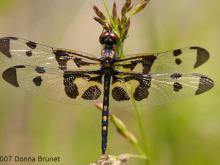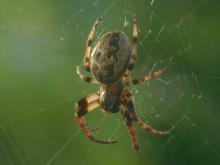Land Invertebrates
Media

Species Types
Scientific Name
Species in the suborder Anisoptera
Description
Like damselflies, dragonflies have long bodies, two pairs of long, membranous, finely veined wings, and predaceous aquatic larvae. Dragonflies typically hold their wings stretched outward, horizontally.
Media

Species Types
Scientific Name
More than 900 species in North America north of Mexico
Description
Millipedes, which have two pairs of legs per body segment, are harmless detritus-eaters, move slowly, and curl up defensively when harassed.
Media

Species Types
Scientific Name
Diapheromera femorata, Megaphasma denticrus, and others
Description
Walkingsticks are long, slender insects that are perfectly camouflaged to look like brown or green twigs. Most species are tropical, but some types are found in Missouri.
Media

Species Types
Scientific Name
Lepisma saccharina, Thermobia domestica, and other species
Description
Silverfish are known worldwide, since they commonly live in our homes. There are a number of species in this family of insects, including the common silverfish and the firebrat.
Media

Species Types
Scientific Name
Loxosceles reclusa
Description
The brown recluse is a spider whose venomous bite may be medically significant to humans, though a bite is almost never fatal. Brown recluses are most commonly encountered in houses, where they occupy little-used drawers, closets, and other small hiding spaces.
Media

Species Types
Scientific Name
Nearly 250 species in North America north of Mexico
Description
A wolf spider doesn't spin webs to catch its prey — it runs it down like a wolf! Spiders in this family have long legs and are usually gray, brown, black, or tan with dark brown or black body markings (especially stripes).
Media

Species Types
Scientific Name
Pisaurina spp.
Description
Nursery web spiders build silken tents in plants to protect their egg sacs, then stand guard until the hatchlings are ready to disperse. Large and velvety, nursery web spiders have long legs and variable color patterns.
Media

Species Types
Scientific Name
Larinioides spp.
Description
Furrow orbweavers have a distinctive dark pattern on the abdomen that resembles a furrow. These harmless spiders are common under the eaves of homes and near porch lights.
Media

Species Types
Scientific Name
About 84 species in North America.
Description
Many blow flies are so shiny and colorful they’re called greenbottles and bluebottles. But pretty as they are, it’s hard not to be repulsed by their larval diets.
Media

Species Types
Scientific Name
Stagomantis carolina, Mantis religiosa, and Tenodera sinensis
Description
Most people recognize mantids, or mantises, when they see them, but it takes more practice to distinguish among the different species of these efficient insect predators.
See Also



Media

Species Types
Scientific Name
Cisseps fulvicollis
Description
The yellow-collared scape moth is more often “orange-collared.” And whether you think it looks more like a firefly or a wasp, it’s still a moth!
Media

Species Types
Scientific Name
Nearly 150 species in North America north of Mexico
Description
Slim, delicate plume moths are instantly recognizable by their T-shaped silhouette, long legs, and muted shades of tan and brown. It can be hard to separate the various species.
Media

Species Types
Scientific Name
Pyrrharctia isabella
Description
Not many people know the adult Isabella tiger moth when they see one, but we’re all acquainted with its caterpillar, the woolly worm, or woolly bear.
About Land Invertebrates in Missouri
Invertebrates are animals without backbones, including earthworms, slugs, snails, and arthropods. Arthropods—invertebrates with “jointed legs” — are a group of invertebrates that includes crayfish, shrimp, millipedes, centipedes, mites, spiders, and insects. There may be as many as 10 million species of insects alive on earth today, and they probably constitute more than 90 percent all animal species.





















